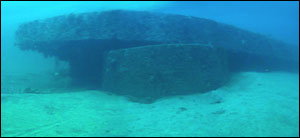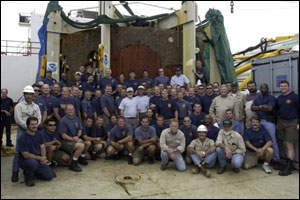Discovery of Monitor Sailors' Remains
The Lost Monitor Boys | Discovery of Remains | Personal Artifacts | First Look
| |  | | |
| | USS Monitor wreck site. Turret lies upside down under the ship's hull. (Courtesy Monitor Collection, NOAA) | |
In 2002, when NOAA archaeologists and U.S. Navy divers worked to raise the Monitor's turret, they operated under the knowledge that there was a potential for encountering human remains. The turret, upside down and completely filled with silt and sediments, was in a perfect position to afford it protection from current scouring. So it was believed that this area would be the most archaeologically intact area of the ship. Therefore, in anticipation of a likely encounter with skeletal remains inside the turret, the Monitor National Marine Sanctuary solicited participation of the US military's Central Identification Laboratory in Hawaii (CILHI).* The sanctuary requested that a forensic anthropologist/archaeologist be present during the expedition.
| |  | | |
| | Group photo of the Monitor 2002 expedition team gathered in front of the turret after it was safely secured on deck. (Courtesy Monitor Collection, NOAA) | |
The first set of skeletal remains was discovered on July 26, 2002, during underwater excavation work being conducted inside of the Monitor's gun turret. Dr. Eric Emery, CILHI, oversaw the partial excavation of the skeletal remains given the field designation of Monitor #1. The skeletal remains from the pelvis up were removed on site. The lower extremities appeared to be leading under the inverted starboard cannon. Because this area was not part of the necessary underwater excavation, archaeologists decided to leave this portion of the skeletal remains in place and recover them after the turret was lifted from the seabed. Dr. Emery returned to Hawaii with the partial skeleton on August 5.
| |  | | |
| | Archaeologists, Wayne Lusardi (left) and John Broadwater began excavating human remains while the turret was still en route to Hampton Roads. (Courtesy Monitor Collection, NOAA) | |
After the turret was recovered on August 6, 2002, archaeologists entered the turret to determine whether to remove the remaining bones onsite or wait until the turret was back in a more controlled environment at The Mariners' Museum. An examination of the skeletal remains revealed that while some bones were embedded in soft silt and mud, others were concreted directly to turret structure. Bones that were in soft sediments were mapped and recovered, as well as some associated artifacts. Bones that were heavily concreted to the structure were left in place until the proper equipment needed to safely remove them from the iron components was available.
On Aug. 9, 2002, for the first time in 140 years, the long submerged revolving gun turret, the most recognizable aspect of the USS Monitor, returned to U.S. soil and arrived at its final resting place at The Mariners' Museum in Newport News, Va. A conservation tank was erected around the turret, and a chiller system was utilized to keep the water in the tank cold to prevent deterioration of the organic materials, particularly the skeletal remains. Shortly after the turret's arrival at the Museum, Dr. Emery returned to Virginia to assist with the documentation and final excavations. Once the remains were removed, they were transferred to CILHI for a detailed forensic examination.
After the forensics were complete, the draft report provided by CILHI, gave the following details about the two sets of remains:
Monitor #1
Race – Caucasoid
Age - 17-24
Stature – 64 ¼ - 68 ½ inches
with a mean stature of 5' 7”
| Monitor #2
Race - Caucasoid
Age – 30 -40
Stature – 66 7/8 – 70 1/8 inches
with a mean stature of 5' 6 ½”
____________________________
*CILHI changed its agency name shortly after the Monitor 2002 Expedition to the Joint POW/MIA Accounting Command (JPAC).
| |


 indicates a link leaves the site. Please view our Link Disclaimer | Contact Us | http://monitor.noaa.gov/150th/includes/footer.html
indicates a link leaves the site. Please view our Link Disclaimer | Contact Us | http://monitor.noaa.gov/150th/includes/footer.html